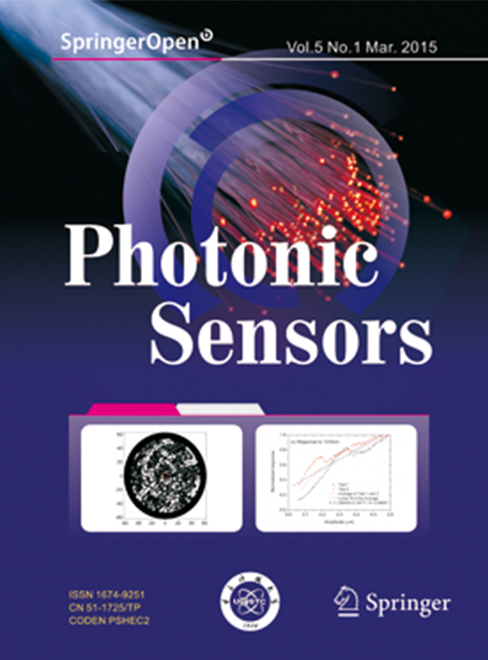 View fulltext
View fulltext
Phase-sensitive optical time domain reflectometry (Ф-OTDR) is an effective way to detect vibrations and acoustic waves with high sensitivity, by interrogating coherent Rayleigh backscattering light in sensing fiber. In particular, fiber-optic distributed acoustic sensing (DAS) based on the Ф-OTDR with phase demodulation has been extensively studied and widely used in intrusion detection, borehole seismic acquisition, structure health monitoring, etc., in recent years, with superior advantages such as long sensing range, fast response speed, wide sensing bandwidth, low operation cost and long service lifetime. Significant advances in research and development (R&D) of Ф-OTDR have been made since 2014. In this review, we present a historical review of Ф-OTDR and then summarize the recent progress of Ф-OTDR in the Fiber Optics Research Center (FORC) at University of Electronic Science and Technology of China (UESTC), which is the first group to carry out R&D of Ф-OTDR and invent ultra-sensitive DAS (uDAS) seismometer in China which is elected as one of the ten most significant technology advances of PetroChina in 2019. It can be seen that the Ф-OTDR/DAS technology is currently under its rapid development stage and would reach its climax in the next 5 years.
Optical fiber sensor networks (OFSNs) provide powerful tools for large-scale buildings or long-distance sensing, and they can realize distributed or quasi-distributed measurement of temperature, strain, and other physical quantities. This article provides some optical fiber sensor network technologies based on the white light interference technology. We discuss the key issues in the fiber white light interference network, including the topology structure of white light interferometric fiber sensor network, the node connection components, and evaluation of the maximum number of sensors in the network. A final comment about further development prospects of fiber sensor network is presented.
Recently, microfiber-optic sensors with high sensitivity, fast response times, and a compact size have become an area of interest that integrates fiber optics and nanotechnology. Distinct advantages of optical microfiber, such as large accessible evanescent fields and convenient configurability, provide attractive benefits for micro- and nano-scale optical sensing. Here, we review the basic principles of microfiber-optic sensors based on a broad range of microstructures, nanostructures, and functional materials. We also introduce the recent progress and state-of-the-art in this field and discuss the limitations and opportunities for future development.
This paper reviews the recent advances on the high-performance distributed Brillouin optical fiber sensing, which include the conventional distributed Brillouin optical fiber sensing based on backward stimulated Brillouin scattering and two other novel distributed sensing mechanisms based on Brillouin dynamic grating and forward stimulated Brillouin scattering, respectively. As for the conventional distributed Brillouin optical fiber sensing, the spatial resolution has been improved from meter to centimeter in the time-domain scheme and to millimeter in the correlation-domain scheme, respectively; the measurement time has been reduced from minute to millisecond and even to microsecond; the sensing range has reached more than 100 km. Brillouin dynamic grating can be used to measure the birefringence of a polarization-maintaining fiber, which has been explored to realize distributed measurement of temperature, strain, salinity, static pressure, and transverse pressure. More recently, forward stimulated Brillouin scattering has gained considerable interest because of its capacity to detect mechanical features of materials surrounding the optical fiber, and remarkable works using ingenious schemes have managed to realize distributed measurement, which opens a brand-new way to achieve position-resolved substance identification.
Fiber Bragg grating (FBG) array is a powerful technique for quasi-distributed sensing along the entire length of sensing fiber with fast response and high precision. It has been widely used for temperature, strain, and vibration monitoring. In this review work, an overview on the recent advances of FBG arrays is conducted. Firstly, the fabrication methods of FBG array are reviewed, which include femtosecond laser system and online writing technique. Then, the demodulation techniques for FBG arrays are presented and discussed. Distributed static sensing can be performed by demodulating wavelength shift of each FBG, while phase demodulation techniques with low noise are employed for dynamic vibration sensing. Simultaneous distributed dynamic and static sensing system based on FBG array is also outlined. Finally, possible future directions are discussed and concluded. It is believed that the FBG array has great development potential and application prospect.
Fiber-optic hydrophone (FOH) is a significant type of acoustic sensor, which can be used in both military and civilian fields such as underwater target detection, oil and natural gas prospecting, and earthquake inspection. The recent progress of FOH is introduced from five aspects, including large-scale FOH array, very-low-frequency detection, fiber-optic vector hydrophone (FOVH), towed linear array, and deep-sea and long-haul transmission. The above five aspects indicate the future development trends in the FOH research field, and they also provide a guideline for the practical applications of FOH as well as its array.
RAO wuyu@uestc.edu.cn, and yjrao@uestc.edu.cn Abstract: Single atomically thick graphene, with unique structural flexibility, surface sensitivity, and effective light-mater interaction, has shown exceptional advances in optoelectronics. It opens a door for diverse functionalized photonic devices, ranging from passive polarizers to active lasers and parametric oscillators. Among them, graphene-fiber biochemical sensors combine the merits of both graphene and fiber structures, demonstrating impressively high performances, such as single-molecule detectability and fast responsibility. These graphene-fiber biochemical sensors can offer tools in various applications, such as gas tracing, chemical analysis, and medical testing. In this paper, we review the emerging graphene-fiber biochemical sensors comprehensively, including the sensing principles, device fabrications, systematic implementations, and advanced applications. Finally, we summarize the state-of-the-art graphene-fiber biochemical sensors and put forward our outlooks on the development in the future.









